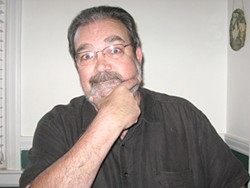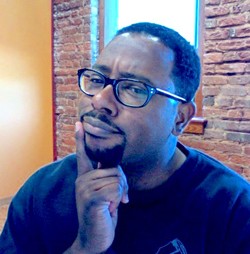
"We had fun, we fought, we made up, and, at least in the editorial department, we never forgot our unofficial motto: 'We're not fucking around.'"
Those words came from John Grooms, Creative Loafing's original local editor who set this paper's swaggering tone and high standards from the beginning. The quote is part of an essay Grooms wrote for the paper's 20th anniversary issue. This week, CL celebrates 30. We're adults now. According to an often-cited aphorism from the 1960s, we can no longer be trusted.
But don't believe that for a second. It's fake news.
Thirty years ago this month, Creative Loafing arrived in the Queen City with a mission that has not changed: Give Charlotte the same intelligent, irreverent, alternative voice to counter that of the city's mainstream daily newspaper in the way that CL's flagship paper had been doing in Atlanta since the early '70s.
The Charlotte edition of Creative Loafing arrived in the late '80s, a time when alt-weeklies had proliferated across the U.S., offering countercultural narratives to the mainstream-media status quo in a similar style to that of the nation's original alternative weekly, The Village Voice, in New York. Since the mid-'50s, the Voice had been a counter-narrative to The New York Times, covering underground jazz and other adventurous music, film and arts movements, as well as publishing hard-hitting investigative news pieces the mainstream press either ignored or soft-peddled. The '60s saw a rise in alt-weeklies nationwide, and in 1978, 30 of them joined forces to form the Association of Alternative Newsweeklies (now changed to Newsmedia); by the time CL reached Charlotte, AAN membership had more than doubled, and today it numbers over 100.
Creative Loafing was a resounding success in Charlotte from the get-go, but it didn't come without a fight. CL was a threat to the Charlotte Observer — so much so that the Big O quickly put together and launched a fake alternative weekly, BREAK, in an attempt to syphon off the Loafing's ad revenue and put the paper out of business. Most readers saw through the ruse, though, and BREAK ultimately broke.

- Grooms
A year after CL's launch here, Grooms — already an associate editor — took the reins (his predecessor had been an editor shipped in from Atlanta), and every week for the next 17 years, under Grooms' astute guidance and (by all accounts) mercurial leadership style, the paper churned out hard-hitting reporting and analyses of local government, music, arts and sports in irreverent, often titillating stories you would never, in a million years, see in the daily paper or its pseudo-alternative tabloid.
During the Grooms years, the Charlotte edition of Creative Loafing took home more than 40 statewide, regional and national journalism awards. (Read Rhiannon Fionn's story on Grooms.)
His shoes were tough to fill when I arrived in 2005 for my first go-round as Creative Loafing's editor. Grooms had set a high bar, not just in terms of what kinds of issues should be covered, but also of in terms of his rigorous journalistic standards and ethics. My objective was to maintain his high standards but expand our coverage. The one area where I saw room for improvement was in diversity, particularly in the coverage of the arts and music. That had been a primary goal of mine at previous publications where I'd served as a top editor, including the music magazines Option and Rolling Stone.
At Creative Loafing, my intent was to assemble a staff and stable of freelancers that better reflected the young and creative Charlotte voices of the early 2000s. In addition to the predominantly white journalists mostly writing about predominantly white underground artists and indie rockers, I wanted CL readers to hear from writers coming out of the exploding Latino community; black journalists writing about black artists and musicians, many of whom came from families that had returned to Charlotte in record numbers as the nation experienced a Great Remigration of African-Americans to the South; and journalists from the city's ever-expanding LGBTQ community.

- Hargro
We made some headway, bringing noted black music journalist Kandia Crazy Horse on board as a full-time editor and hiring more black and Latino freelance reporters and columnists. But it wasn't until I left a year later and Carlton Hargro arrived in 2006 that real progress was made.
Hargro, CL's first African-American editor-in-chief, and his assistant editor Kim Lawson (who would later become the paper's first Asian-American editor), made a radical shift in Creative Loafing's voice and coverage, laying the foundation for the Loafing you read each week today. And they achieved this during an unprecedented turbulent time for the news industry, in general, and for CL, specifically. (Read Lawson's conversation with Hargro about media diversity.)
In 2008, the rug was pulled from under alt-weeklies — not to mention everybody else — nationwide when the recession hit. Creative Loafing's Atlanta flagship went bankrupt and fell into ownership limbo. After I returned in 2012, the paper went through two different owners, including the SouthComm corporation, whose resources allowed us the opportunity to provide solid coverage of the Democratic National Convention. But the corporate model was breaking down.

- Lawson
I left again two years later, moved to the San Francisco Bay Area where I did a brief stint as editor-in-chief of SF Weekly, and Kim Lawson took the reins. She continued her focus on keeping diverse voices in the CL mix, but pages and staff dwindled, and eventually she moved on, too. When I returned for my third go-round earlier this year, Creative Loafing had come full circle: It was back under independent ownership but with a smaller staff than ever.
The upside of all this turbulence is that CL Charlotte's current staff is as passionate and committed as I've ever seen it. What's more, the current owner, Charles Womack, is the company's first North Carolina-based publisher and he's equally as passionate about Creative Loafing.
It's comforting to know that CL Charlotte has weathered so many storms over the past 30 years and come out of them with more autonomy than I've seen at the paper since my first arrival in 2005. But that also means that we have fewer resources. And that has forced us to do a lot of soul-searching and asking tough questions: What's Creative Loafing's primary purpose in Charlotte? What do we do best? What can we provide to you that no other media outlet does?
The answers, as I see it: We can cover local news and local arts with intelligence, attitude and depth, and we can leave the national news events and national musicians and artists to the national media. You don't need CL to tell you about Donald Trump's ties to Russia. And you don't need CL to tell you about Snoop Dogg's latest collaboration or Dawes' newest album. When those artists come to town (and they're coming), we may do a blurb on them in the Top 10 Things to Do, but that's it.
Charlotte today generates more than enough local arts, music and news events every day that it would be silly for us to waste valuable time and space on stories about a national artist or news event that you can get in your Twitter feed. So we won't. Our guiding principle today is to keep it local, and we aim to stick to that. We want you to know what's going in all areas of your community. We may sometimes take you outside of your comfort zone, but we won't take you outside of Charlotte.
Do I wish we had more internal diversity than we do now. Yes, absolutely. We have not yet mastered total diversity. But we will keep trying. And we will remain committed to keeping a diverse stable of freelance voices who will help ensure that stories and issues do not get lost in our blind spot. And even though the staff at CL today is smaller than ever, we are an enthusiastic, tightly knit team willing to do whatever it takes to get a great paper on the streets and content on the website and social media.
A decade ago, in that 20th anniversary issue, John Grooms reflected on CL's earliest years: "Enthusiasm is what held the paper together. There was a sense in the early, founding days of CL-Charlotte that we were doing something this city needed," he wrote. "Truth be told, that kind of faith — and a dedicated owner — can take a new publication a long way. So we persevered, we improvised, we learned, and, well, here we are."
Another truth: That very same kind of faith is why our little staff today is able to celebrate Creative Loafing's 30 years of nonstop coverage in Charlotte. And the paper's first local editor deserves more than a little credit for that. After all, it was John Grooms who set the tone.


